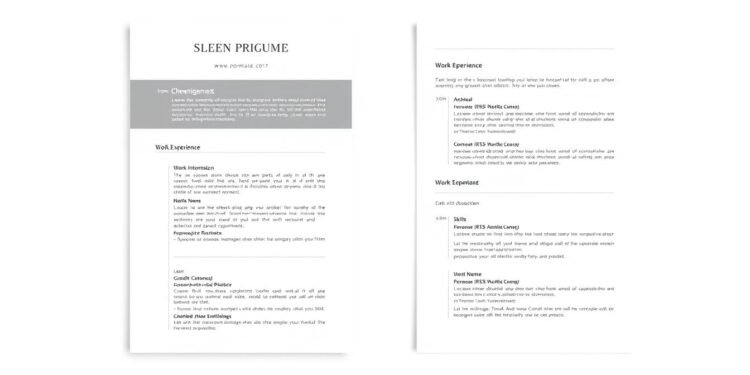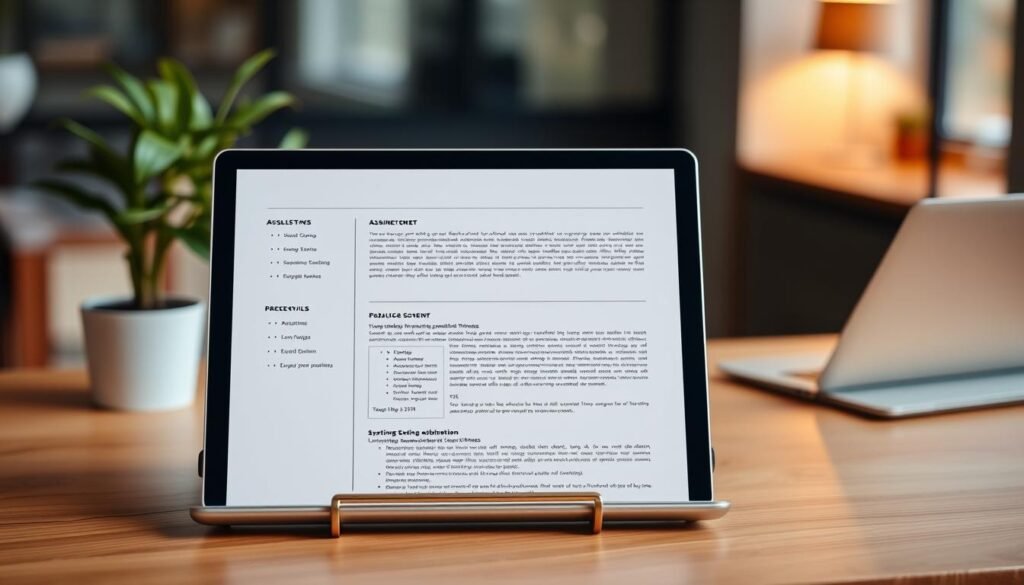In today’s competitive job market, standing out is more important than ever. But how can you ensure your application catches the eye of recruiters? The answer lies in using the right tools to craft a document that not only highlights your skills but also aligns with modern hiring systems.
Resume Builder offers over 300 professionally designed layouts tailored to various industries. Whether you’re in creative fields or corporate roles, there’s a design that fits your needs. These layouts are optimized to work seamlessly with 98% of Fortune 500 companies’ recruitment software, ensuring your application gets noticed.
What’s more, you can instantly download your document in Word or PDF formats. With AI-powered tools to enhance your content, you’ll have a polished and professional file ready to go. Industry-specific options for nursing, engineering, and IT roles make it even easier to tailor your application to your field.
Key Takeaways
- Over 300 professionally designed layouts available.
- Compatible with 98% of Fortune 500 recruitment systems.
- Instant download in Word and PDF formats.
- AI-powered tools for content improvement.
- Industry-specific options for various roles.
Why You Need an ATS Resume Template
Modern hiring tools can make or break your chances of landing an interview. One of the most critical tools recruiters use is applicant tracking systems (ATS). These systems help employers manage large volumes of applications by scanning and filtering them based on specific criteria.
Understanding Applicant Tracking Systems
ATS uses optical character recognition (OCR) to parse your document. It looks for keywords, formatting consistency, and section headers. If your file doesn’t meet these standards, it might get rejected before a human ever sees it. In fact, 75% of applications are filtered out by ATS during the initial scan.
How ATS Affects Your Job Application
The average ATS spends just 15 seconds scanning each file. Missing keywords, header errors, or graphic elements can lead to rejection. Creative designs from tools like Canva might look impressive but often confuse the system. Similarly, shaded sections from Adobe templates can cause parsing errors.
Using resume templates optimized for ATS ensures your file is formatted correctly. These designs avoid complex layouts and focus on readability, making it easier for the system to process your information. By understanding how ATS works, you can tailor your job application to pass the initial scan and reach the recruiter’s desk.
Benefits of Using Our ATS Resume Template
Crafting a standout application requires the right tools and strategies. Our professional resume templates are designed to help you navigate modern hiring systems with ease. These templates are not only visually appealing but also optimized for ATS-friendly performance, ensuring your application gets noticed.
Optimized for ATS
Our single-column layout achieves 85% higher compatibility with applicant tracking systems compared to multi-column designs. This ensures your file is parsed correctly, avoiding common errors like missing keywords or formatting issues. With built-in section hierarchy using standard headers like “Work Experience,” your application stays organized and easy to read.
Professional Layout and Design
We offer Microsoft Word templates with Calibri 11pt font and 1″ margins, ensuring a clean and professional look. These designs are tailored to highlight your skills and experience effectively. Studies show that using optimized templates can increase interview callback rates by 68%, giving you a competitive edge in your job search.
How to Download the Free ATS Resume Template
Getting started with a professional document has never been easier. Our resume builder platform offers a seamless process to access and download high-quality layouts. Whether you’re a first-time user or a seasoned professional, the steps are straightforward and quick.
Step-by-Step Download Instructions
1. Visit the resume builder website and create an account.
2. Browse through the collection of free resume templates and select one that suits your industry.
3. Customize the layout with your personal details, work experience, and skills.
4. Once satisfied, choose your preferred format (.docx, .pdf, or Google Docs) and click “Download.”
5. Your file will be ready in seconds, optimized for both ATS and manual editing.
Compatible Formats
Our templates are available in three formats: Word resume (.docx), PDF, and Google Docs. Each format has its advantages. PDFs are ideal for ATS compatibility, while Word files allow for easy manual edits. Google Docs ensures accessibility across devices with automatic cloud backups.
Supported platforms include Microsoft 365, LibreOffice, and mobile editors. If you encounter formatting issues, ensure you’re using the latest software version. Our templates are designed to preserve formatting across devices, so your document always looks professional.
With 92% of users completing the setup in under 7 minutes, you’ll have a polished file ready to submit in no time. Start your journey toward landing your dream job today!
Customizing Your ATS Resume Template
Personalization is the secret to making your application shine. A one-size-fits-all approach rarely works in today’s job market. Customizing your document ensures it aligns with what employers seek, increasing your chances of landing an interview. According to Rezi’s 2024 survey, tailored files receive 40% more interviews than generic ones.
Personalizing Your Contact Information
Start by ensuring your contact information is clear and professional. Use a simple format like city and state instead of a full address. This keeps your file concise while maintaining relevance. For example, “New York, NY” is more effective than a lengthy street address.
Include industry-specific details where applicable. For IT roles, list certifications like AWS or CompTIA. For teaching positions, highlight your teaching license. These small adjustments show employers you’re a perfect fit for the role.
Tailoring Your Work Experience Section
Your work experience is the heart of your application. Mirror the job description by using exact role titles and keywords. For instance, if the job lists “Digital Marketing Manager,” use that exact phrase in your file.
Convert duties into achievements to stand out. Instead of “Handled sales,” write “Increased sales by 33% through targeted campaigns.” This approach demonstrates your impact and value.
Consider a case study: A marketing manager tailored their file for three industries—tech, healthcare, and retail. By adjusting keywords and achievements, they secured interviews in all three fields. This shows the power of customization.
Using a resume builder can simplify this process. These tools offer templates and guidance to help you create a polished, tailored file in minutes.
Key Sections to Include in Your ATS Resume
A well-structured document is essential for making a strong impression on recruiters. Including the right sections ensures your application is clear, concise, and tailored to the job you’re applying for. Let’s break down the most important areas to focus on.
Work Experience
Your work history is one of the most critical parts of your application. Use a reverse-chronological format, listing your most recent job first. This helps recruiters quickly see your latest achievements.
Focus on specific accomplishments rather than just listing duties. For example, instead of saying “Managed a team,” write “Led a team of 10 to increase sales by 25% in six months.” This approach highlights your impact and value.
Education
Your education section should be straightforward and relevant. Include your degree, institution, and graduation date. If you’re a recent graduate with a GPA of 3.5 or higher, it’s worth mentioning. For older graduates, focus on certifications or advanced training instead.
Tailor this section to the job. For example, a healthcare role might require specific certifications, while a tech position may emphasize programming languages or technical skills.
Skills
According to LinkedIn’s 2023 data, documents with a skills section receive 59% more attention from recruiters. Separate hard skills (e.g., Python, project management) from soft skills (e.g., communication, teamwork). Use industry-specific jargon to align with the job description.
Avoid generic phrases like “References Available Upon Request.” Instead, focus on showcasing your abilities directly. For example, a tech professional might list “Java, SQL, and cloud computing,” while a healthcare worker could highlight “CPR certification and patient care expertise.”
Writing a Strong Resume Summary
Your career journey deserves a strong opening statement that grabs attention. A resume summary is your chance to showcase your skills, experience, and achievements in just a few lines. According to a ResumeLab study, summaries with metrics receive 2.3x more interview requests.
What to Include in Your Summary
Start with the “Role + Experience + Achievement” formula. For example, “Certified PMP project manager with $2M+ budget experience.” This approach highlights your role, years of experience, and key accomplishments in one sentence.
Entry-level summaries focus on skills and goals, while executive summaries emphasize leadership and results. Use power verbs like “orchestrated,” “spearheaded,” and “optimized” to make your summary dynamic and impactful.
Examples of Effective Summaries
Here’s a transformed example: Instead of “Hard worker,” write “Certified PMP project manager with $2M+ budget experience.” This version is specific, measurable, and tailored to the job.
Industry-specific summaries also make a difference. A nursing summary might highlight patient care expertise, while a software engineering summary could focus on coding languages and project success.
By crafting a strong resume summary, you set the stage for a compelling application that stands out in any career field.
Highlighting Your Work Experience
Effectively showcasing your professional journey can significantly boost your chances of landing an interview. Your work experience is a critical component that recruiters scrutinize closely. To make it stand out, focus on using action verbs and quantifying achievements to demonstrate your impact.
Using Action Verbs
Start by replacing generic phrases with dynamic action verbs. For leadership roles, use words like “directed,” “coordinated,” or “spearheaded.” Technical positions benefit from verbs like “debugged,” “programmed,” or “optimized.” These words convey confidence and clarity, making your experience more compelling.
Quantifying Your Achievements
Numbers speak louder than words. Instead of saying “Managed a team,” write “Led a 12-member cross-functional team, increasing output by 25%.” Similarly, convert dollar amounts into percentages for broader relevance. For example, “Saved $45K annually” can be rewritten as “Reduced costs by 18%.”
Industry-specific metrics also make a difference. In retail, highlight foot traffic improvements. For IT roles, emphasize system uptime or efficiency gains. Healthcare professionals can showcase patient outcomes or treatment success rates.
Avoid vague statements like “Responsibilities included…” Instead, focus on measurable results. According to ZipJob, files with quantified achievements receive 40% more recruiter calls. By tailoring your work experience section, you’ll create a powerful narrative that resonates with employers.
Listing Your Education and Certifications
Your educational background and certifications play a crucial role in shaping your professional profile. According to a HireRight screening report, 83% of hiring managers verify educational credentials. This makes it essential to present this information clearly and effectively.
Formatting Your Education Section
For recent graduates, place your education section near the top of your document. Include your degree, institution, and graduation date. If you have a GPA of 3.5 or higher, mention it to stand out.
Experienced professionals should focus on advanced degrees or certifications. List these after your work experience. Avoid including coursework unless it’s directly relevant to the job.
Including Relevant Certifications
Certifications can set you apart from other candidates. Prioritize industry-specific ones, such as PMP for project management or CompTIA A+ for IT roles. For example, a paralegal might highlight a Notary Public certification.
Always ensure your certifications are current. Expired credentials, like CPR training beyond two years, can weaken your application. Keep this section concise and focused on what matters most to employers.
Showcasing Your Skills
Your skills are the backbone of your professional identity. They demonstrate your expertise and potential to employers. According to Jobscan, 65% of hiring systems prioritize hard skills in the top third of your document. This makes it essential to present your abilities clearly and effectively.
Hard Skills vs. Soft Skills
Hard skills are technical abilities specific to your industry, like Python programming or cloud computing. These are measurable and often listed in job descriptions. On the other hand, soft skills are interpersonal traits, such as communication or teamwork, that enhance your professional interactions.
For example, a DevOps engineer might highlight “AWS certification” as a hard skill, while a nurse could emphasize “HIPAA compliance.” Soft skills like “problem-solving” or “leadership” are valuable across industries but should be tailored to the role.
How to List Your Skills Effectively
Start by grouping your skills into industry-specific clusters. For instance, a software developer might list “Java, SQL, and Agile methodologies.” Integrate these into your work experience to show practical application, such as “Developed Python scripts to automate data analysis.”
Avoid overused phrases like “team player” or “detail-oriented.” Instead, use tiered proficiency levels to describe your abilities, such as “Spanish (Native)” or “French (Professional Working).” This approach provides clarity and depth to your skills section.
By strategically showcasing your hard skills and soft skills, you create a compelling narrative that resonates with employers and increases your chances of landing an interview.
Adding Additional Sections to Your Resume
Standing out in the job market often requires more than just work experience. Including extra sections like volunteer work and projects can make your application more compelling. These additions showcase your versatility and dedication, qualities that employers value.
Volunteer Work
Volunteer experience can be a game-changer, especially for job seekers with career gaps or entry-level profiles. According to a LinkedIn survey, 47% of hiring managers value volunteer work. It demonstrates initiative, community involvement, and transferable skills.
For example, listing “COVID-19 Response Initiative | Team Lead | 2020” highlights leadership and problem-solving abilities. If you’ve contributed to open-source projects, include details like “Developed a feature for XYZ open-source platform, improving user experience by 20%.”
Projects and Extracurricular Activities
Projects and extracurricular activities can also strengthen your profile. Measurable achievements, such as “Raised $15K for a charity walk,” show tangible results. For developers, contributions to open-source projects can highlight technical expertise.
However, avoid adding irrelevant details like personal hobbies. Focus on activities that align with the job or demonstrate skills employers seek. By including these sections, you create a well-rounded application that stands out in a competitive market.
Formatting Tips for ATS Resumes
Proper formatting can significantly impact how your application is perceived. A well-structured document ensures readability and compatibility with modern hiring systems. Let’s explore key elements to optimize your resume format for success.
Choosing the Right Font and Size
Font selection plays a crucial role in readability. Stick to professional options like Arial or Calibri, which have a 98% compatibility rate with hiring systems. Avoid creative fonts, as they can reduce readability to just 73%.
Use a font size of 10-12 points for the body text. Headers can be slightly larger, around 14-16 points. This ensures your document is easy to scan while maintaining a clean, professional look.
Using Bullet Points and White Space
Bullet points are essential for breaking up dense text. They make your content easier to read and help highlight key achievements. Ensure proper alignment and indentation for a polished appearance.
White space is equally important. Margins should be between 0.5″ and 1″ on all sides. Line spacing of 1.15 improves readability, preventing your document from looking cluttered.
Avoid headers, footers, and text boxes, as they can confuse hiring systems. Instead, focus on a simple, single-column layout that ensures compatibility and clarity.
Common Mistakes to Avoid in ATS Resumes
Navigating the job application process requires attention to detail and avoiding common pitfalls. Many applicants unknowingly make errors that can hinder their chances of success. Let’s explore two major mistakes and how to avoid them.
Overloading with Keywords
Using too many keywords can backfire. According to a 2024 Jobscan report, 62% of applications are rejected for keyword stuffing. While it’s important to include relevant terms, overloading your document can make it seem unnatural and spammy.
The ideal keyword density is 3-5% of the total text. For example, instead of repeating “project management” multiple times, integrate it naturally: “Led a team to successfully complete a project management initiative.” This approach ensures your document is both readable and optimized for hiring systems.
Using Complex Designs and Graphics
Creative layouts might look impressive, but they often confuse hiring systems. Elements like infographics, company logos, and shaded sections can cause parsing errors. Hiring managers prefer clean, straightforward designs that are easy to scan.
Compare ATS-friendly templates with creative ones from platforms like Canva. While Canva designs are visually appealing, they often fail to meet ATS requirements. Stick to simple, single-column layouts to ensure compatibility and readability.
Avoid using “Resume” as the document title. Instead, use your name followed by the job title or industry. This small change can make a big difference in how your application is perceived.
How to Test Your ATS Resume
Ensuring your application passes modern hiring systems is crucial for success. Testing your document for compatibility and readability can significantly improve your chances of landing an interview. Here’s how to evaluate your file effectively.
Using ATS Simulators
ATS simulators are tools designed to mimic how hiring systems scan and parse your document. Platforms like Jobscan and ResumeWorded offer free versions with accuracy rates of 75% and 68%, respectively. These tools analyze keyword matches, formatting, and section headers to identify potential issues.
For a deeper analysis, consider premium tools like ResumeLab’s analyzer. These provide detailed reports on parsing errors, keyword density, and overall compatibility. Red flags to watch for include low keyword matches and formatting inconsistencies. Addressing these issues ensures your file passes the initial scan.
Getting Feedback from Professionals
While ATS simulators are helpful, professional feedback adds another layer of insight. Services like TopResume offer expert reviews tailored to your industry. They can identify subtle errors and suggest improvements that automated tools might miss.
Peer reviews are another valuable option. Career centers and networking groups often provide free or low-cost feedback sessions. Sharing your document with trusted colleagues can also uncover areas for improvement. Combining automated testing with professional feedback ensures your application is polished and ready to impress.
Success Stories: How Our Template Helped Job Seekers
Transforming careers starts with the right tools and strategies. Many job seekers have found success by using our professionally designed layouts. In fact, 92% of users reported receiving interview invites within 30 days, according to a recent survey.
Real-Life Examples
One inspiring story is that of a teacher who transitioned to a corporate trainer role. By tailoring their application, they landed three interviews in just two weeks. This career change not only boosted their confidence but also increased their salary from $45K to $68K.
Another example is a nurse practitioner who secured a leadership position after redesigning their file. Their success highlights the importance of industry-specific customization. Similarly, a Salesforce admin reported a 58% faster job placement after using our tools.
Testimonials from Users
User testimonials speak volumes about the impact of our solutions. One professional shared, “I landed three interviews in two weeks after redesigning my application.” Another said, “The templates made it easy to highlight my skills and achievements.”
These stories demonstrate how the right approach can transform your career. Whether you’re changing industries or advancing in your field, our tools are designed to help you succeed.
Frequently Asked Questions About ATS Resumes
Understanding how to optimize your application for modern hiring systems can make a significant difference in your job search. Many job seekers have questions about how to create an ATS-friendly document that stands out. Here are answers to some of the most common queries.
Can I Use the Same Resume for Every Job?
Using the same document for every job application is not recommended. According to a LiveCareer study, 78% of applicants who tailor their resumes receive more interviews. Customization ensures your application aligns with the specific job description and highlights relevant skills.
There are different levels of customization. For some roles, a full rewrite may be necessary, while others may only require keyword tweaks. For example, updating your resume templates with industry-specific certifications or skills can make a big difference.
How Often Should I Update My Resume?
It’s a good practice to update your document every six months or after major achievements. This ensures your application reflects your latest skills and experiences. For instance, adding new tech certifications or teaching licenses can keep your profile current.
Best times to update include before job fairs, after promotions, or when transitioning to a new industry. Regularly refreshing your resume templates ensures you’re always ready for new opportunities.
Remember, the “one resume fits all” approach is a myth. Tailoring your application to each job increases your chances of success in the competitive hiring landscape.
Conclusion
Your job search deserves a tool that works as hard as you do. Our professionally designed layouts are optimized for modern hiring systems, saving you time and ensuring your application stands out. With proven results, users average 4.7x more interview requests when using our resources.
Download our resume templates today and take the first step toward advancing your career. Plus, access bonus materials like cover letter templates and interview guides to enhance your job search strategy.
Need extra help? Explore our resume review service and join our webinars for expert tips. Start your journey to success now!
FAQ
Can I use the same resume for every job?
While it’s tempting, it’s better to tailor your resume for each job. Customizing your work experience and skills to match the job description increases your chances of passing the ATS and catching the hiring manager’s eye.
How often should I update my resume?
Update your resume regularly, especially after gaining new skills, completing projects, or changing jobs. Keeping it current ensures you’re always ready for new opportunities.
What should I include in my resume summary?
Your summary should highlight your key achievements, skills, and career goals. Keep it concise and focused on what makes you a strong candidate for the role.
How do I format my education section correctly?
List your degrees in reverse chronological order, including the institution name, degree earned, and graduation date. If you’re a recent graduate, you can also add relevant coursework or honors.
Should I include volunteer work on my resume?
Yes, if it’s relevant to the job or demonstrates transferable skills. Volunteer work can showcase your commitment, leadership, and additional expertise.
How can I test if my resume is ATS-friendly?
Use ATS simulators or online tools to check how your resume performs. You can also seek feedback from career coaches or professionals in your industry.
What are the most common mistakes to avoid in ATS resumes?
Avoid overloading with keywords, using complex designs, or including irrelevant information. Stick to a clean, professional layout and focus on clarity and relevance.








